We Explore Top 10 Benefits of Asset Tracking Systems
Helpful Summary
- Overview: This article explores the benefits of asset tracking systems for effective equipment management, highlighting how BlueTally enhances productivity and efficiency throughout the asset lifecycle.
- Why You Can Trust Us: With our expertise in IT asset management solutions, we possess a deep understanding of the needs and challenges related to asset tracking. This background equips us to provide valuable insights into effective strategies.
- Why It Matters: An efficient asset tracking system reduces human error and theft, leading to significant cost savings and improved operational performance
- Action Points: We recommend adopting BlueTally for streamlined asset tracking, maintenance, and management. Integrating it with your existing systems will provide real-time insights.
- Further Research: For more insights, check out our resources on predictive maintenance, inventory control, and asset management dashboards on our blog.
Are you tired of losing track of your valuable assets and seeking ways to optimize your business operations while reducing costs? Asset tracking systems offer a comprehensive solution. By automating and optimizing asset management, businesses can prevent theft, reduce unnecessary expenses, and maximize asset utilization.
According to Webisoft, companies leveraging IoT for asset tracking have seen a significant boost in asset efficiency, with a 20% reduction in maintenance costs and a 15% improvement in overall equipment effectiveness.
In this guide, we’ll explore the benefits of asset tracking systems, focusing on how tools like BlueTally can revolutionize your business.
Why Listen to Us?
Understanding the benefits of asset tracking systems is essential for enhancing operational efficiency. At BlueTally, we focus on tackling the challenges associated with managing a wide variety of assets. Our hands-on experience in assisting businesses in optimizing their asset management showcases our expertise.
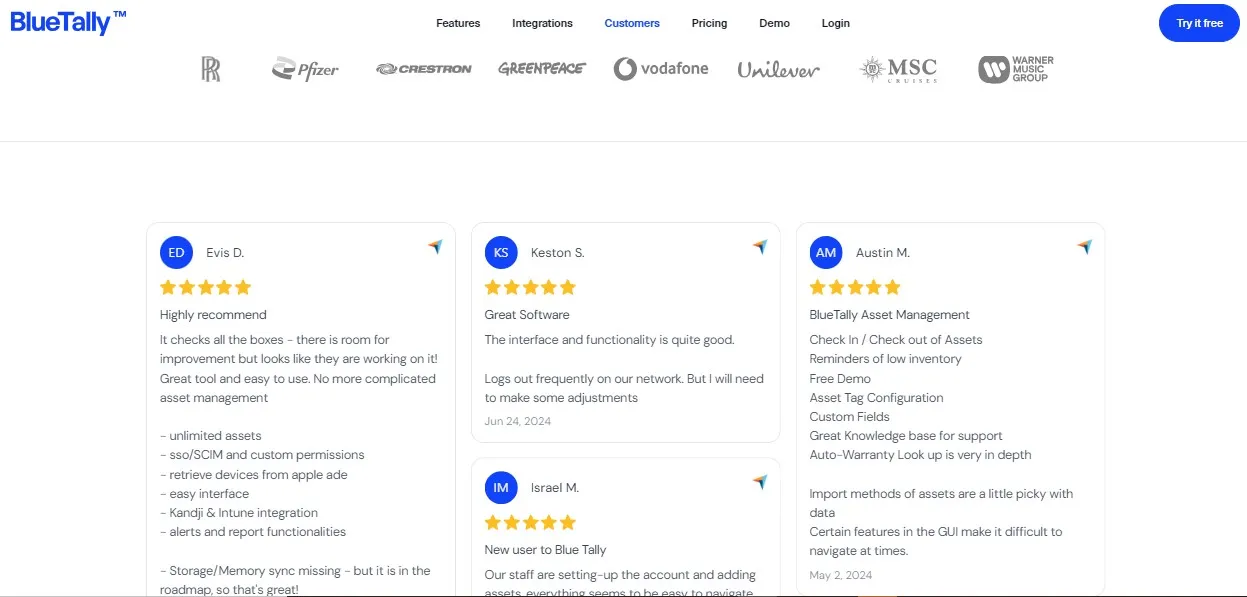
BlueTally has been instrumental in enhancing asset management for clients, especially in the IT sector, through integrations with platforms such as Intune and Jamf. These initiatives streamline asset management processes while intensifying security and compliance, backed by our SOC 2 certification.
What are Asset Tracking Systems?
Asset tracking systems are technologies used to monitor and manage physical and digital assets within an organization. They help businesses keep tabs on their equipment, tools, vehicles, and more, ensuring that every asset is accounted for and utilized efficiently.
At its core, an asset tracking system involves tagging assets with identifiers like barcodes or QR codes, which can be scanned to update the asset's status in a central database. This system allows businesses to track the movement, usage, and condition of their assets in real-time. For example, a construction company can monitor the location and utilization of their tools on job sites, reducing the risk of theft or loss.
One great example of an asset tracking system is BlueTally. Our cloud-based solution is designed to help businesses efficiently manage their assets. It offers real-time tracking, extensive integrations, and customizable features tailored to meet unique business needs. Trusted by prominent clients like Pfizer and Greenpeace, BlueTally stands out as a top choice for small to medium-sized businesses.

Key Benefits of Asset Tracking Systems
1. Increased Efficiency and Productivity
Implementing an asset tracking system significantly boosts efficiency and productivity. By automating the tracking process, businesses can save time and reduce manual errors.
For example, BueTally’s real-time tracking capabilities ensure that businesses have constant visibility into the status and location of their assets. This system allows for the seamless tracking of items, helping companies to monitor the movement and usage of their equipment.

A company can use our platform to easily track assets such as a laptop assigned to an employee, including detailed information on its check-in and check-out history. This level of detailed oversight ensures that assets are used efficiently and remain accounted for at all times, ultimately contributing to more organized and effective asset management practices.
2. Cost Savings
Asset tracking systems prevent unnecessary purchases by providing detailed asset utilization data, leading to more strategic decision-making. Businesses can also reduce maintenance costs by scheduling regular upkeep based on asset condition and usage history.
For instance, BlueTally’s integration with Microsoft Intune exemplifies how technology can enhance asset management. This integration allows businesses to automate asset assignment and tracking, which drastically reduces the need for labor-intensive manual data entry. By streamlining these processes, companies can save hours of work each week, freeing up employees to focus on more strategic tasks. The time and effort saved translate into lower operational costs, improving the overall bottom line.
Moreover, the automation reduces the likelihood of human error, ensuring data accuracy and reliability. In a competitive business environment, such innovations in asset tracking can offer a significant edge in terms of productivity and cost-effectiveness.
3. Enhanced Security
Tracking assets can also enhance security by preventing theft and unauthorized use. By leveraging technology such as real-time monitoring and alerts, businesses can maintain tighter control over their assets, thereby protecting their investments.
With an advanced asset tracking system, businesses can strengthen their security measures by setting up alerts for suspicious activities and maintaining a detailed log of asset movements. This allows organizations to respond swiftly to any anomalies and maintain a secure environment for their operations.
BlueTally’s SOC 2 certification further ensures that their asset tracking solutions adhere to rigorous security protocols. The system allows businesses to set up notifications for asset check-ins and check-outs, promoting accountability among users and preventing unauthorized use. By implementing such comprehensive measures, companies can significantly reduce the risk of asset loss and improve overall operational efficiency.
4. Improved Maintenance and Lifecycle Management
Effective maintenance and lifecycle management are critical for maximizing the lifespan and performance of assets. Asset tracking systems enable organizations to schedule maintenance proactively and monitor the health of assets.
BlueTally allows businesses to schedule and track maintenance activities. For example, a company can set up regular maintenance reminders for their fleet of vehicles, ensuring they remain in optimal condition.
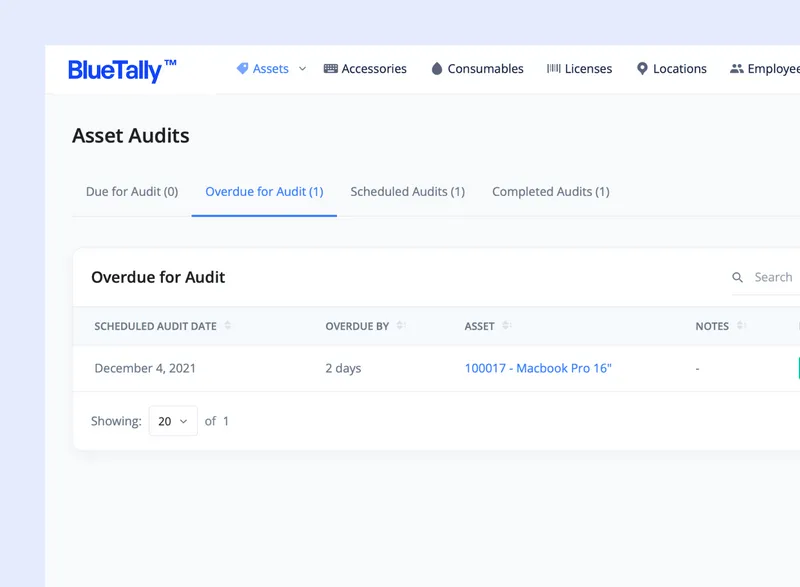
5. Better Decision Making
Asset tracking systems generate data-driven insights that allow for better decision-making. Businesses can analyze usage patterns, identify underutilized assets, and make informed decisions about purchasing and allocation.
BlueTally’s custom fields and reports allow users to generate detailed asset reports. You can create reports based on specific criteria, such as “All assets expiring within 90 days,” to make proactive decisions about replacements or upgrades.
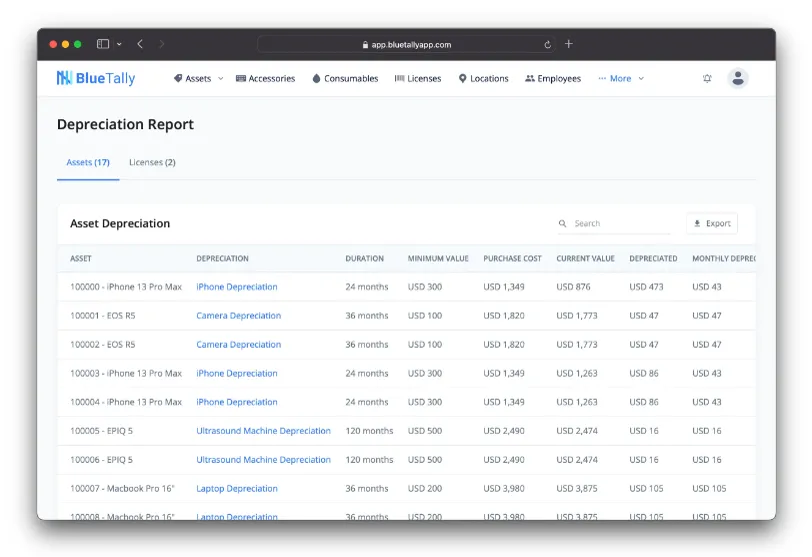
6. Compliance and Auditing
Maintaining compliance with industry regulations and standards is essential for many businesses. Asset tracking systems ensure up-to-date records and proper asset documentation, which simplifies the auditing process.
BlueTally’s maintenance and auditing features ensure that assets are properly accounted for and maintained. For example, a medical facility can use BlueTally to log and schedule maintenance for their equipment, ensuring compliance with healthcare regulations.
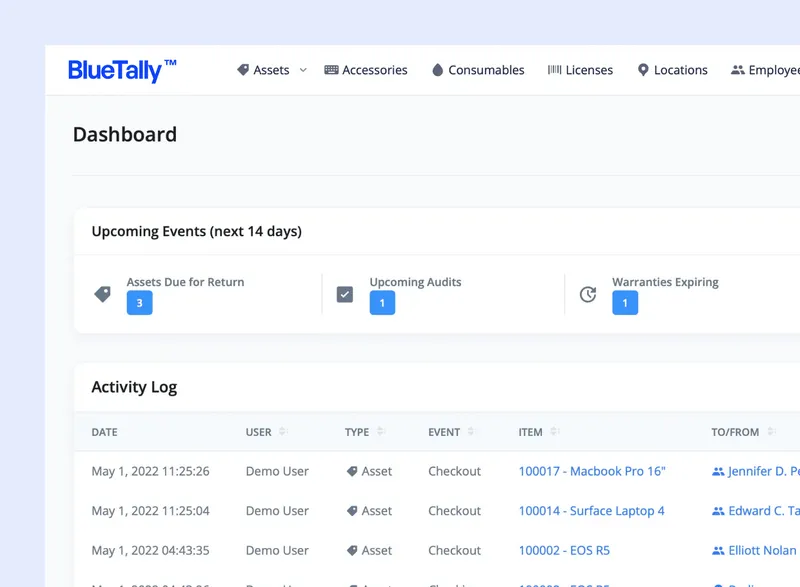
7. Customizability and Scalability
Businesses have unique needs and requirements when it comes to asset management. No wonder, the asset management system market is projected to exceed $27 billion by 2025, with a compound annual growth rate of 10.3% from 2020 to 2025.
Asset tracking systems like BlueTally offer customizable features and scalability to accommodate growth and changing needs. Our platform allows users to create custom fields and reports, making the tool adaptable to specific business needs. A company tracking different types of licenses, for example, can create unique fields for renewal dates, ensuring timely renewals.
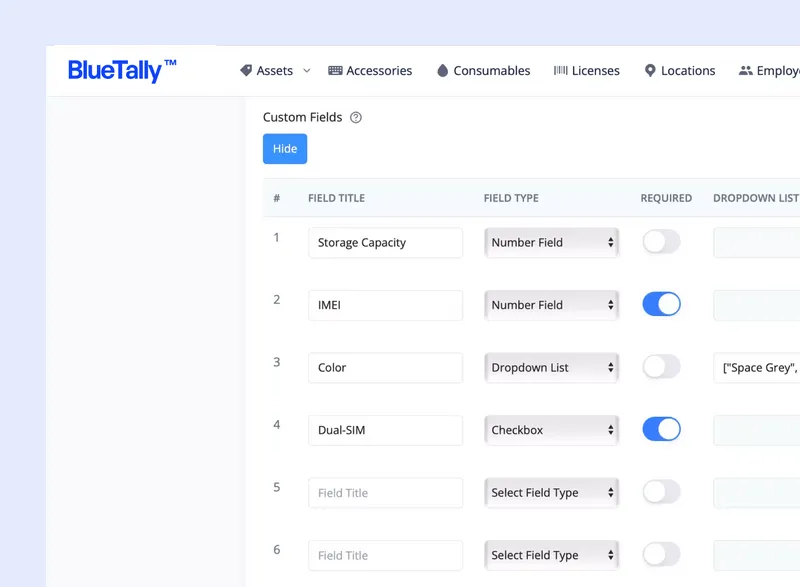
8. Enhanced Employee Accountability
Asset tracking systems improve employee accountability by providing a transparent record of asset assignments and usage. This transparency encourages responsible use and reduces asset misuse.
According to a study, 80% of employees waste 30 minutes a day retrieving information, which amounts to a full working day every three weeks.
BlueTally’s real-time tracking and notification features ensure that employees are accountable for the assets assigned to them. For instance, employees receive reminders to return assets on time, reducing the likelihood of lost or misplaced items.
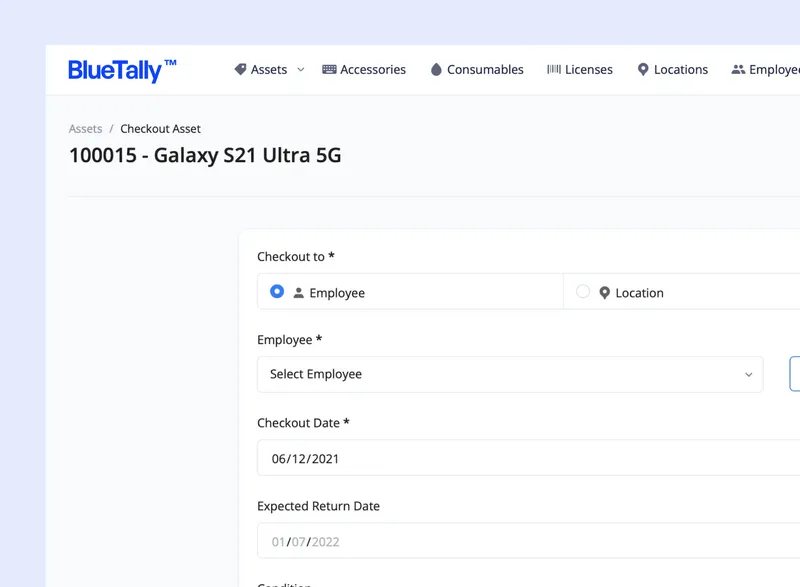
9. Integration with Existing Systems
Achieving seamless integration with existing systems is vital for reaping the full benefits of asset tracking. Asset tracking solutions, such as BlueTally, provide integrations with leading IT management and communication tools, enhancing efficiency and oversight
BlueTally integrates with Microsoft Intune, Jamf, Azure Active Directory, and other tools, allowing businesses to manage all assets from one platform. This integration saves time and ensures consistency across systems.

10. User-Friendly Interface
A user-friendly interface is essential for helping employees navigate the asset tracking system efficiently. 43% of small businesses do not track their inventory or rely on manual processes, leading to inefficiencies and inaccuracies. A user-friendly interface can address these challenges by encouraging adoption, simplifying tracking processes, and minimizing errors.
BlueTally’s intuitive design makes it easy to use, even for teams transitioning from manual systems. Users can quickly learn to assign assets, track history, and generate reports with minimal training.
Conclusion
Asset tracking systems offer a comprehensive solution to managing physical and digital assets, leading to increased efficiency, cost savings, better security, and improved decision-making.
BlueTally stands out as a top choice for businesses looking to implement an asset tracking system. Its real-time tracking, robust integrations, customizable features, and user-friendly interface make it a powerful tool for managing assets effectively.
Ready to optimize your operations? Try BlueTally for free today and experience the transformation in your asset management.






